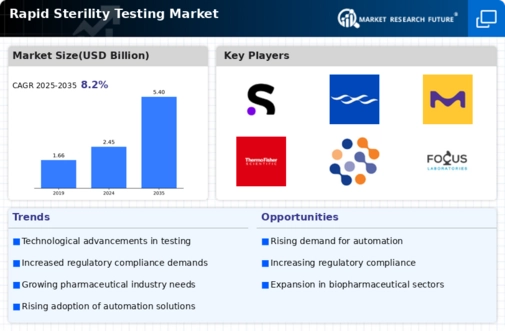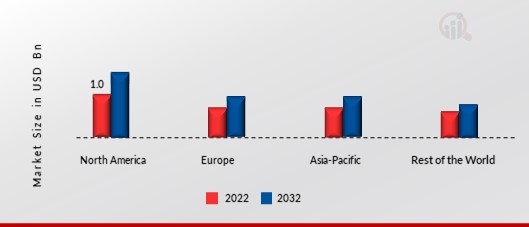Market Trends
Key Emerging Trends in the Rapid Sterility Testing Market
The Rapid Sterility Testing market is undergoing transformative trends driven by advancements in pharmaceutical manufacturing, regulatory requirements, and the need for faster and more reliable sterility testing methods. Rapid Sterility Testing is crucial for ensuring the safety of pharmaceutical products, and this overview outlines key market trends shaping the landscape of this industry. The increasing focus on regulatory compliance is one of the major trends in Rapid Sterility Testing market. The regulatory authorities are becoming increasingly strict with regards to enforcing the sterility standard specifications for pharmaceutical products. This is driving firms to opt for rapid sterility testing techniques that are fast and comply with measurements, fulfilling the dynamic regulatory environment. The technologies used in the testing platforms are leading to change an evolution of Rapid Sterility Testing market. Sophisticated techniques, which involve adoption of automated systems and development of novel detection technologies increase the speed and accuracy in sterility testing. Such a trend reveals that the industry plans to find modern technical solutions more accurate. Rapid Sterility Testing Market is witness to the growing adoption of real-time microbial monitoring. This trend is basically about the continual monitoring of manufacturing environments and processes for microbial contaminants. When real-time monitoring is implemented, proactive identification of looming issues becomes possible due to which prompt corrective actions may be undertaken and the requirement for subsequent sterility test after production would almost reduce. A significant turn to use fast sterility testing methods for product release in pharmaceutical manufacturing is observed. However sterility test methods are mostly time consuming and this may result into production delay. Rapid techniques provide faster results thereby enabling manufacturers to simplify their production processes so as bring products into the market more effectively. The market is observing the incorporation of sophisticated analytical methods in quick sterility testing. Techniques including, polymerase chain reaction (PCR), nucleic acid amplification in addition to ATP bioluminescence are being used for quick detection and quantitation of microbial contaminants. This growth improves sterility testing sensitivity and specificity, leading to reliable detection ability. The trends in the market imply an interest to standardize and harmonization of standards for proper rapid sterility test protocol. Consistency, comparability, and compliance are encouraged when testing methods and protocols are unified in the industry. In line with the solution of various testing approaches, this trend aims to solve challenges associated with diverse test environments and ensures a more unified landscape. The market is advancing towards high demand rates for disposable sterility test systems. Disposable systems curtail the risk of cross contamination by limiting need for thorough cleaning which may be time consuming and the more extensive process involved in validations is not necessary. This strengthen the industry culture of improving sterility testing efficiency and reliability. It is mostly by strategic collaborations and mergers that shape the market of Rapid Sterility Testing. Organizations continue to form collaborations so that they can merge their expertise, technologies and other resources required for the production of sophisticated rapid sterility tests. Such collaborative trend further enhances the pace of innovations and increases in market’s responsiveness to emerging industry needs. The future outlook for the Rapid Sterility Testing market involves the integration of Industry 4.0 technologies. Smart manufacturing, data analytics, and connectivity are expected to play a significant role in enhancing the efficiency and reliability of sterility testing. This futuristic trend positions rapid sterility testing as an integral component of the digitized and interconnected pharmaceutical manufacturing landscape.










Leave a Comment